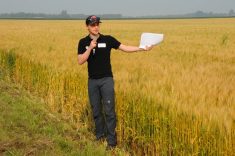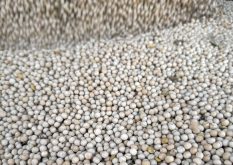If you’re one to look at food labels, chances are you’ve seen the results of the high-tech research taking place at POS Bio-Sciences.
You won’t see the name, but it’s there — in proteins, fibres, starches and oils.
The Saskatoon-based company is a global player in developing new processes that use crops such as peas and lentils to extract higher-value ingredients to make foods more nutritious or more cost competitive.
Its goal is nothing less than being a catalyst for changing the food world. And much of what POS Bio-Sciences uses is grown on the Prairies.
Read Also

Research looks to control flea beetles with RNAi
A Vancouver agri-tech company wants to give canola growers another weapon in the never-ending battle against flea beetles.
“We’ve got global attention to look at Western Canada,” said Rick Green, vice-president of technology at POS Bio-Sciences. “Now they’re looking to say there (are) all these value-added opportunities. What more can I do with pulse rather than just the whole pulse? … Now there’s an ingredient industry that we know it’s developing. And it’s global.
“We work from all over the world with clients that are looking for pulse-based ingredients. The consumer will see it on the ingredient label.”
With clients in six continents, POS Bio-Sciences’ ingredients reside in the labels of breads, specialty teas, infant formula, bovine colostrums, soy beverages ,cosmetics and many more products.
Research involves esoteric processes, such as developing microcapsules that can help oil proteins better digest in livestock rumens and increase nutrition in bread due to better performance of the oil in ovens.
“Back in the ’80s, we were talking about total utilization of our crops; that might be starch, the protein, the fibre and the oil,” said Green. “Total utilization now means taking that protein, extracting the protein and fractionating it.”
Ripping apart crops into their component parts and then ripping apart some of those parts and improving them to make them more nutritious, for example, is a major ambition in the developing ingredient industry.
“You’re taking a raw material or a new seed or crop and extracting something and developing a process that someone hasn’t done before,” said Green. “Now it’s much more sophisticated than protein starch and fibre. (It’s) what type of protein, what type of starch, what type of oil? … What new, innovative ingredient can we develop that the world needs?”
Much of the research produces incremental improvements, but they are significant.
“A eureka moment might be that I was able to remove a step from this process that reduces the (production) cost from $1 per kilo to 80 cents per kilo and that’s a eureka moment for us because you know it’s a more competitive product,” said Green.
The research is meticulous and the payoff could be significant: food companies looking for a more sustainably produced product, using less water or a lower carbon footprint in the processing, or even developing what is essentially a new ingredient.
“We … look for gaps in the industry and proactively develop processes which ultimately become new ingredients,” said Green. “We talk about process, but it’s really a different ingredient, like an organic ingredient might be looked at differently than a traditional ingredient.”
Ben Kelly, business development manager, notes improvements in processes and changing the value of ingredients can lead to significant development.
“The larger companies we work with, they’re going to spend $100 million and build a 100,000 sq. foot manufacturing plant to make the ingredients that we’re developing here,” he said.
And new consumer demand can come from cultural issues or changing demographics.
“Companies … talk about producing for millennials,” said Green. “They educate themselves and they decide their eating habits and the industry believes that. They see that opportunity.”
Good research is crucial. There are many more clinical trials and nutritional studies behind claims on the labels, said Green.
POS Bio-Sciences is working on a new, water-based process, shifting from a dry processed ingredient that is 55 percent protein, to a protein content of 80 percent or more.
The company sometimes teams up its research with the University of Saskatchewan to conduct work for producer groups such as Saskatchewan Pulse Growers and the Canadian Canola Growers Association, whose check-off dollars help fund projects.
Protein extracted from fababeans, and lentil protein, are in development.


















